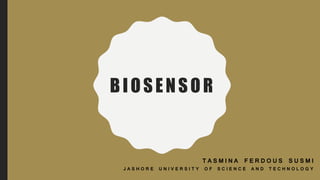
Biosensor
- 1. BIOSENSOR T A S M I N A F E R D O U S S U S M I J A S H O R E U N I V E R S I T Y O F S C I E N C E A N D T E C H N O L O G Y
- 2. BIOSENSOR • The term “biosensor” is short for “biological sensor” • A device made up of a transducer and a biological element that may be an enzyme, an antibody, or a nucleic acid. • Has a biological component that acts as the sensor and an electronic component • Detects and transmits the signal. • The first biosensor was invented in the year 1950 by American biochemist “L. C. Clark”.
- 3. MAIN COMPONENTS OF A BIOSENSOR Biosensor Elements Biological Elements Enzymes Cells Antibody Physical Elements Transducer Amplifier Electric Potencial
- 4. MAIN COMPONENTS OF A BIOSENSOR • Analyte: A substance of interest that needs detection. • Bioreceptor: A molecule that specifically recognizes the analyte is known as a bioreceptor. • Transducer: The transducer is an element that converts one form of energy into another. • Electronics: This is the part of a biosensor that processes the transduced signal and prepares it for display. • Display: The display consists of a user interpretation system such as the liquid crystal display that generates numbers or curves understandable by the user.
- 5. MAIN COMPONENTS OF A BIOSENSOR
- 6. WORKING PRINCIPLE OF BIOSENSOR • Analyte diffuses from the solution to the surface of the Biosensor. • Analyte reacts specifically & efficiently with the Biological Component of the Biosensor. • This reaction changes the physicochemical properties of the Transducer surface. • This leads to a change in the optical/electronic properties of the Transducer Surface. • The change in the optical/electronic properties is measured or converted into
- 7. WORKING PRINCIPLE OF BIOSENSOR Biological Material Bound Analyte Biological Response Electronic Response Measurement Analyte
- 8. CHARACTERISTICS OF A BIOSENSOR • Selectivity perhaps the most important feature of a biosensor. Selectivity is the ability of a bioreceptor to detect a specific analyte in a sample containing other admixtures and contaminants. • Reproducibility is the ability of the biosensor to generate identical responses for a duplicated experimental set-up. • Stability is the degree of susceptibility to ambient disturbances in and around the biosensing system. • Sensitivity The minimum amount of analyte that can be detected by a biosensor defines its limit of detection (LOD) or sensitivity.
- 9. PROPERTIES OF A GOOD BIOSENSOR • Highly specific for the analyte. • The response should be linear. • The device should be small & biocompatible. • It should be low cost, small & easy to use. • Assay cost should be lower than conventional tests. • The assay should be fast, reliable & repeatable.
- 10. TYPES OF BIOSENSORS • Electrochemical Biosensor o Amperometric Biosensors -Principle- Movement of electrons o Potentiometric Biosensors -Principle- Detects ionic Conc. o Impedimetric Biosensors -Principle- Electrochemical Impedence spectrometry o Voltammetric Biosensors -Principle-Carbon glue electrodes with HB • Physical Biosensor o Piezoelectric Biosensors -Principle- Detect sound, vibration, frequencies o Thermometric Biosensor -Principle- Detects Heat by thermistor
- 11. TYPES OF BIOSENSORS • Optical Biosensor • Wearable Biosensors • Enzyme Biosensor • DNA Biosensor • Immunosensors • Magnetic Biosensors • Resonant Biosensors • Thermal Detection Biosensor
- 13. GLUCOSE SENSORS • The first enzyme-based electrode for glucose detection was reported by L. L Clark in 1962 • are designed to detect glucose levels • is vital to managing diabetes • selective, sensitive, and relatively easy to use
- 14. • Reduces risk of developing complications with diabetes. • Allows diabetics to see if the insulin and other medications they are taking are working. • Gives diabetics an idea as to how exercise and food affect their blood sugar. • May prevent hypoglycemia or hyperglycemia. WHY MONITOR BLOOD GLUCOSE?
- 15. COMMON ENZYMES IN GLUCOSE SENSORS Common enzymes (bioreceptors) that are used to detect glucose include: • Glucose oxidase (GOx) • Glucose dehydrogenase (GDH) Enzyme with Co-factor • Glucose dehydrogenase nicotinamide adenine dinucleotide (GDH-NAD) • Glucose dehydrogenase flavin adenine dinucleotide (GDH-FAD) • Glucose dehydrogenase pyrroloquinoline quinone (GDH-PQQ)
- 16. WORKING PRINCIPLE • Analyte: glucose is the analyte that the biosensor is designed to detect. • Bioreceptor: For the detection of glucose, specific enzymes are used, which are proteins that facilitate a chemical reaction. • Transducer: Most modern-day glucose meters and continuous glucose monitors measure electrical signals, although earlier generations of glucose meters used a colorimetric process (color change) that was measured optically. • Electronics and display: These components process the transduced signal and prepare it for display.
- 17. MECHANISM OF GLUCOSE SENSORS
- 18. EVOLUTION OR GENERATION OF GLUCOSE SENSORS Generation Description Advantages/Drawbacks First generation It works on oxygen reduction to hydrogen peroxide. Drawback: possible interference of compounds (e.g. ascorbic acid) presented in the blood. Original wire electrodes were expensive. Second generation It uses electron mediators instead that replace oxygen in the reaction. Advanced types of embranes are also used. Advantage: the assay is less sensitive to interferents like ascorbic acid Third generation It is based on the direct electron transfer between enzyme and membrane/electrode – electron can be replaced by conductive membrane; other of enzymes can be used. It exerts similar analytical properties like the 2nd generation, the absence of electron mediator makes the process simpler and avoiding problematic materials. Fourth Enzyme in the biosensor is replaced by an artificial structure exerting similar catalytical properties including specificity like the original enzyme. Advantage: easier mass production, better uniformity and reproducibility. the other hand, specificity should be verified.
- 19. EVOLUTION OR GENERATION OF GLUCOSE SENSORS
- 20. THE DIFFERENT TYPES OF GLUCOSE SENSORS JBkj • Discrete form (blood glucose meter test strips) or cbkjb • Wearable form (a continuous glucose monitor).
